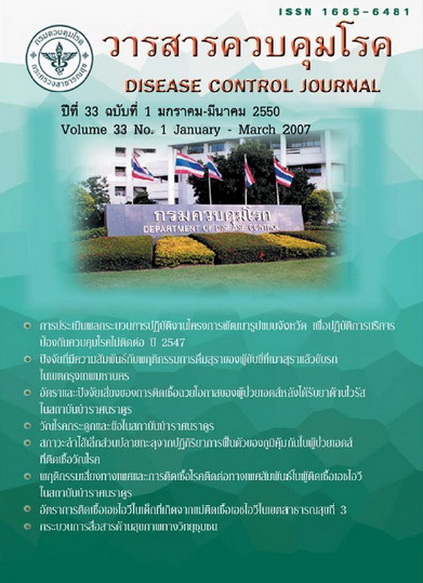Perinatal HIV Transmisson Rate in the Public Health Region 3
Keywords:
Perinatal HIV Transmission, Public Health Region 3Abstract
This cross - sectional survey was aimed to evaluate the HIV transmission rate from mother to infant and the uses of antiretroviral drug prophylaxis regimen in mother and infant. The causes of failure to follow up of infant for HIV infected diagnostic work up were also determined. All 456 infants who were born from HIV serological positive mothers between October 1, 2002 and September 30, 2004 in Nakhonsawan, Kamphaengphet, Pichit and Uthaithani provinces were enrolled. The data were collected using individual case record form designed for this study. It was found that 90.3% of HIV infected mothers had antenatal care, 49.4% received Zidovudine (AZT) prophylaxis during pregnancy for more than four weeks. About 85.8% received AZT during labour. Of 443 infants (97.1%) whose record were attained, 98.4% were live birth 48.6% and 48.9% of infants received AZT 1 week and 6 weeks respectively and 20.0% of infants received Nevirapine (NVP). About 78.1% of the infants was followed until HIV infected diagnostic work up was completaely done. The most common problem of failure to follow up among infants was the changes of address of untracable. Among infants which could be evaluated, the perinatal HIV transmission rate was 7.8%. In conclusion, by increasing the ANC accessibility and antiretroviral drug prophylaxis accessibilty of HIV infected mother and strengthening hospital referral system might help improving the effectiveness of perinatal HIV prevention program.
Downloads
References
2. Shearer WT , Quinn TC , La Russa P. Viral load and disease progression in infants infected with human immunodeficiency virus type 1. N Eng J Med. 1997; 336: 1337- 42.
3. Landsman SH, Kalish L, Burns DN. Obstetrical factors and the transmission of human immunodeficiency virus from mother - to - child. N Engl J Med. 1996; 334: 1617-23.
4. Minkoff H, Burns DN, Landesman S. The relationship of the duration of ruptured membranes to vertical transmission of human immunodeficiency virus. Am J Obstet Gynecol. 1995; 173: 585 - 9.
5. Bertolli J, St Louis ME, Simonds RJ. Estimating the timing of mother - to - child transmission of human immunodeficiency virus in a breast feeding population in kinshaha, Zaire. J Infect Dis. 1996; 174: 722 - 6.
6. ชัยยะ เผ่าผา, มลุลี แสนใจ, ตติยา สารริมา. ศึกษาการจัดระบบบริการเพื่อการติดตามและดูแล ทารกที่คลอดจากแม่ที่ติดเชื้อ HIV ของโรงพยาบาล ในพื้นที่เขต 7. อุบลราชธานี: ศูนย์อนามัยที่ 7; 2547.
7. เฉลิมพงษ์ ศรีวัชรกาญจน์. อัตราการติดเชื้อเอชไอวี จากมารดาสู่ทารก โดยการใช้ยา Zidovudine และ Nevirapine ในโรงพยาบาลสมุทรปราการ. วารสาร ควบคุมโรค 2546; 29: 264-72.
Downloads
Published
How to Cite
Issue
Section
License
Articles published in the Disease Control Journal are considered as academic work, research or analysis of the personal opinion of the authors, not the opinion of the Thailand Department of Disease Control or editorial team. The authors must be responsible for their articles.






